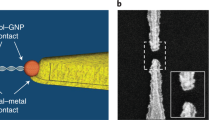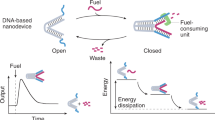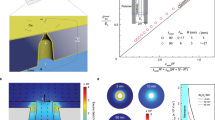Abstract
The question of whether DNA is able to transport electrons has attracted much interest, particularly as this ability may play a role as a repair mechanism after radiation damage to the DNA helix1. Experiments addressing DNA conductivity have involved a large number of DNA strands doped with intercalated donor and acceptor molecules, and the conductivity has been assessed from electron transfer rates as a function of the distance between the donor and acceptor sites2,3. But the experimental results remain contradictory, as do theoretical predictions4. Here we report direct measurements of electrical current as a function of the potential applied across a few DNA molecules associated into single ropes at least 600 nm long, which indicate efficient conduction through the ropes. We find that the resistivity values derived from these measurements are comparable to those of conducting polymers, and indicate that DNA transports electrical current as efficiently as a good semiconductor. This property, and the fact that DNA molecules of specific composition ranging in length from just a few nucleotides to chains several tens of micrometres long can be routinely prepared, makes DNA ideally suited for the construction of mesoscopic electronic devices.
This is a preview of subscription content, access via your institution
Access options
Subscribe to this journal
Receive 51 print issues and online access
$199.00 per year
only $3.90 per issue
Buy this article
- Purchase on Springer Link
- Instant access to full article PDF
Prices may be subject to local taxes which are calculated during checkout



Similar content being viewed by others
References
Dandliker, P. J., Holmlin, R. E. & Barton, J. K. Oxidative thymine dimer repair in the DNA helix. Science 257, 1465–1468 (1997).
Arkin, M. R. et al. Rates of DNA-mediated electron transfer between metallointercalators. Science 273, 475–480 (1996).
Lewis, F. D. et al. Distance-dependent electron transfer in DNA hairpins. Science 277, 673–676 (1997).
Beratan, D. N., Priyadarshy, S. & Risser, S. M. DNA: insulator or wire? Chem. Biol. 4, 3–8 (1997).
Fink, H.-W., Stocker, W. & Schmid, H. Holography with low energy electrons. Phys. Rev. Lett. 65, 1204–1206 (1990).
Schmid, H. & Fink, H.-W. Carbon nanotubes are coherent electron sources. Appl. Phys. Lett. 70, 2679–2680 (1997).
Fink, H.-W., Schmid, H., Ermantraut, E. & Schulz, T. Electron holography of individual DNA molecules. J. Opt. Soc. Am. A 14, 2168–2172 (1997).
Austin, R. H. Stretch genes. Phys. Today 32–38 (February (1997).
Acknowledgements
We thank our colleagues for discussions; G. Ehrlich for comments on the manuscript; and E. Ermantraut and K. Wohlfart for the design and production of the Quantifoil sample holders. This work was supported by the Swiss National Science Foundation and the Swiss priority program MINAST.
Author information
Authors and Affiliations
Corresponding author
Rights and permissions
About this article
Cite this article
Fink, HW., Schönenberger, C. Electrical conduction through DNA molecules. Nature 398, 407–410 (1999). https://doi.org/10.1038/18855
Received:
Accepted:
Issue Date:
DOI: https://doi.org/10.1038/18855
This article is cited by
-
Mapping for BPS Solitons of Scalar Field Potentials in \(1 + 1\) Dimensions and Family of Solutions
Brazilian Journal of Physics (2023)
-
From molecular to supramolecular electronics
Nature Reviews Materials (2021)
-
Effect of cytosine hydroxymethylation on DNA charge transport
Molecular and Cellular Biochemistry (2021)
-
Backbone charge transport in double-stranded DNA
Nature Nanotechnology (2020)
-
Adenine based molecular junction as biosensor for detection of toxic phosgene gas
Journal of Molecular Modeling (2020)
Comments
By submitting a comment you agree to abide by our Terms and Community Guidelines. If you find something abusive or that does not comply with our terms or guidelines please flag it as inappropriate.



